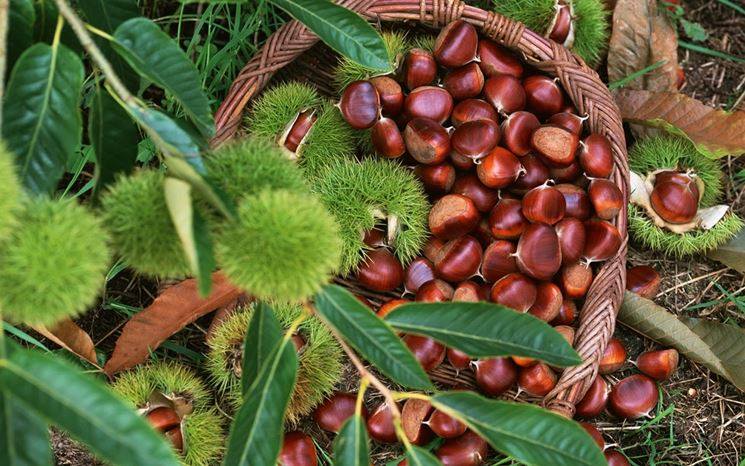TIRANA, February 3

Roasted chestnuts and wine make an incomparable duo, simple, yet exquisite. It was a tradition in some parts of Northern Albania like Pulti in Shkodra to roast chestnuts before dinner. If guests arrived they would be served chestnuts and wine. On other occasions, when there was a food shortage, chestnuts would be the only source of nutrition available to not sleep hungry.
This is the reason Albanians consider chestnuts as blessed trees, but mostly bread trees as they replaced food during times of crisis or wars. In the north, there’s a saying that goes “A chestnut husk has three nuts, one for the owner, one for the harvester, and one for the poor, or the hungry that passes by the tree.”
In some areas, chestnuts were preserved and dried in the ground in order to be used for flour over the year. The practice that is now risking disappear is known as ‘gazhnjete’. Some mills in Tropoja still grind chestnuts flour.
Chestnuts are considered native plants in Albania. They account for vast forestry areas and define the phytoclimate or the area known as the Castanetum Area. Chestnuts grow in mountainous terrains up to 700 meters above sea level. They protect the land and attract wildlife. Chestnuts create large woodlands and smaller forests. The latter are known as ‘kashnjete’ while lower chestnut forests are named ‘cungjishte’. Most of the forest consists only of chestnut trees, mostly centennials. However, it’s not possible to say if they were initially planted by humans due to a lack of data. Chestnuts can be also found in mixed oak forests or close to old churches or monasteries. Monks gave a major contribution to the spread of chestnuts in Albania as they planted the trees close to their convents or created entire forests during the middle ages. They wanted to provide food resources for local communities.

Afterward, the chestnut forests became part of the collectivization reform during communism. The conditions of chestnuts improved due to more organized management and more trees were planted. According to data from the forestry cadaster, in 1985 chestnuts grew in an area of 13,000 hectares all over Albania. Nowadays, about 3,250 hectares of chestnut forests, mostly in the Tropoja area, are certified as organic. A survey conducted in 2010 by Dylan Barclay on Tropoja Chestnuts highlights that the reputation of those specific nuts is related to the size (big) and special taste (sweeter than other domestic chestnuts or imported ones).
Given that chestnuts have always been produced in mountainous areas, they are a key source of income for remote communities. Many poor families still depend on chestnuts for consumption and sale.
Chestnuts export

According to tridge.com, Albania ranks 11th in the global chestnut market. It represents the most important nut product in terms of production and international trade. A survey conducted by the Albanian Agribusiness Support Facility shows that the total chestnuts production has slightly reduced from 6,600 tons in 2015 to about 5,846 tons in 2019. The most important chestnut areas are found in the Tropoja region (the main area of chestnut production, with a huge massif of about 2000 hectares), followed by Malesi e Madhe, Dibra, Puka, Shkodra, Bulqiza, Librazhdi, and Mati.
Based on AASF data, the total export of chestnuts in 2019 was 2,157 tons (representing about Lek 343 million, or about 1percent of the agriculture sector exports). The figure decreased by 39 percent compared to 2015. Italy is the main market for Albanian raw chestnuts. The report highlights that Albanian chestnuts are among the lowest in the global market. This is due lack of product standards and poor post-harvest processes.
There are various reasons why the chestnut processing industry in Albania is limited. There is a small number of companies operating in the sector. Their operations mostly consist of size sorting, washing, drying, packaging, and peeling.
According to the Investment Council estimations, an investment of about Euro 8 million would be needed to meet the domestic and international markets demand.
Where to find chestnuts in Albania

Tropoja chestnut is registered as a unique trademark. Reci in Shkodra is another popular area. The chestnuts and chestnut honey from these two areas are four out of a total of eight registered GIs (geographical indication). The list of GI products includes Tropoja Alps Blueberry, Kuksi Blueberry, Korabi Water, and the Kid goat of Hasi.
In terms of annual production, these are the areas with the highest number of trees in Albania
Tropoja: 190,000
Dibra: 24,688
Malesi e Madhe: 22,990
Puka: 16,000
Shkodra: 10,070
Bulqiza: 9,726
Librazhd: 8,000
Mat: 6,365
Devoll: 3,960
Pogradec: 3,750
Elbasan: 3,298
Kukes: 2,017
Korca: 1,488
Kolonja: 640
Total no. trees: 336,514
The main actors in the chestnut production sector are:
Farmers, who harvest chestnuts from forests, mostly on public property where they have customary rights. Besides chestnut harvesting, most of the farmers are involved in activities such as storage and selection.
Traders
There are over 30 traders in Albania who compete to collects chestnuts from farmers.
Wholesalers
The number of chestnut wholesalers is limited, one is the chestnut cooperative of Reci, in general, the first quality of the product is sold in the domestic market at a high price, while the second and third quality is sold to export markets.
There are a limited number of wholesalers/exporters in the chestnuts sector and no marketing
Challenges:
Difficult access to credit
Diseases
Ownership issues
Insufficient or lack of cold/storage facilities and processing lines
Low yields in natural forests due to lack of maintenance
Lack of marketing operations
Read also: Albanian Products: The Vorba of Gojan
Albanian Products: The Mishavine Cheese of Kelmendi
Top Regional Albanian Products: Traditional Products by Region
Albanian Products – Overview
Things You Can Only Buy in Albania
Source: AASF, Investment Council,FAO

Leave a Reply
You must be logged in to post a comment.